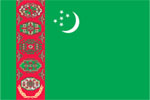| -MAIN
MENU- |
 |
|
 |
|
 |
ABOUT REPUBLIC OF TURKMENISTAN |
 |
| ABOUT TURKMENISTAN |

REPUBLIC OF TURKMENISTAN |
Elaborately woven, bright crimson carpets created by the delicate
hands of nomadic tribal women have become the artistic symbol
of Turkmenistan, a country of sweeping deserts which played
a vital role in the history of the Silk Road Three centuries
before Christ, the Parthian tribes of horsemen arrived to
establish their capital in Turkmenistan at Nisa When their
empire eventually encompassed much of Central Asia, the Parthians
were a power which rivaled Rome From Nisa, the Parthians controlled
the Silk Road and oasis settlements and trading centers like
the region's harsh desert cities of Merv and Serakhs Ruins
of these ancient sites, excavated and studied by international
teams of archaeologists, can be visited and enjoyed today
Turkmenistan later gained fame throughout Central Asia for
producing the skilled and fierce nomadic tribes men who rode
out on raids to seize the riches of the passing caravans These
days more benign tribal customs such as hospitality are making
Turkmenistan famous.
|
| What to See |
- The Ancient City of Merv is one of the
oldest inhabi ted sites in Central Asia At one point in
its history, Merv was called"The Pearl of the East" Razed
by the Mongols it was rebuilt over the centuries and today
five distinct cities cover 130 square kilometers
- Serakhs was a Silk Road oasis on the route
from Nishapur in nearby Persia to Merv and was in its
heyday from the 10th to 12th centuries Once known for
its architectural wonders, Serakhs now boasts the mausoleums
of Abul-Fazy, Yarti-Gumbez and Shiekh Lokman
- Kunya-Urgench was the capital of old Khorezm,
which in the 8th century was the largest indepen dent
Muslim state in Central Asia At one point in its history
the city was called Gurgenj and flourish ed as a stopover
on the Silk Road artery to Russia Today, pre Mongol monu
ments and ruins of mauso leums, minarets and fort resses
attract visitors.
|
| How to Get There |
Turkmenistan's capital Ashgabat
has regularly scheduled air links with London, Frankfurt, Moscow,
Abu Dhabi New Delhi Karachi, Tehran, Istanbul and other regional
foreign cities Tourists can also enter the country at the Caspian
Sea port of Turkmenbashi Within Turkmenistan there is air service
to provincial cities from the capital All Silk Road sites are
served by air rail or road transport.
|
| Where to Stay |
There is a network of modern hotels around
the country with nine five star establishments for 648 people,
three four star hotels for 53 people and two two star hotels
which can accommo date 91 people There are also more modest
facilities Ashgabat's better hotels have conference facilities.
|
| Other Important Sites |
- Mashad-Misrian, an ancient oasis and trading
center on the Khorezm-Persia route, is now a jumble of ruins
of fortress walls and towers, mos ques, mausoleums and minarets
Recently discovered remains of three caravanserais from
the 11th to 12th centuries attest to the city's mercan tile
past
- Annau Fortress is near the capital and boasts
15th century ruins
- The Medieval City of Abiverd was an important
trading post from the 5th to the 7th centuries
- Daja-Khatm Caravanserai is a remarkable structure
dating from the 13th century
- Amul Fortress dates from the 15th century
and is located near Chard) ev
- The Ancient Settlement of Parau is
centred around Kizil-Arvat
|
| Location |
The Republic of TURKMENISTAN occupying
over 717, 300 sq. km, is the Turkmenistan lies in the very center
of the Central Asia. This Location predetermined historically
its great geopolitical importence on the major transasian lines
of communication between the East and the West. Turkmenistan
border with Kazakhstan, Uzbekistan, Iran and Afganistan.
|
| Relief |
Turkmenistan covering vast territory
is notable for the extremely diverse relief: from high snowy
mountains to steppes, semidesert and desert. The lowest place
in the World, situated in the West.
|
| Klimate |
Climate of Turkmenistan is sharp
continental.
|
| Population |
Turkmenistan is a multinational
state. There are over 5 million inhabitans in Turkmenistan
today. Turkmen make 48%, Russia 30%, other nationalities (over
100) 22%.
|
| Language |
| Turkmen and Russia, the official
landuage of the country, belongs to the TURK group. Russan
remains the language of the interethnic communication.
|
| Religion |
Multinationality of the state determines
a divirsity of religions. The main ones are Islam & Christianity.
|
| Capital |
The city of ASHGABAD with the population
of 600 thousands is the capital of Turkmenistan. Ashgabad
was founded as a Russia garrison town three days after the
killing of 20000 Turkmens at GeokTeppe in 1881, and was hit
by earthqake's in 1893, 1895 and 1929. In 1948 the earthquake
completely destroed the city and killed 110, 000. |
|
|
|
-TURKMENISTAN- |
 |
|
 |
|



